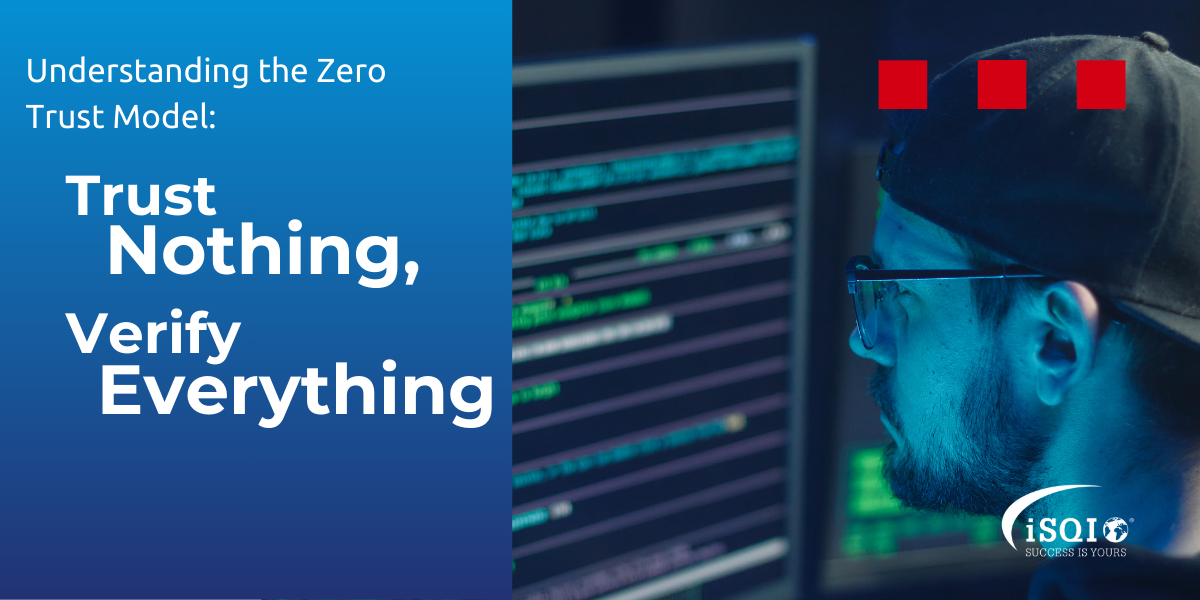Enter the Zero Trust model, a paradigm shift in cybersecurity that emphasizes “trust nothing, verify everything.”
As the digital landscape becomes more complex, traditional security approaches are proving inadequate against the growing sophistication of cyber threats. Perimeter-based security, which relies on securing the network's outer boundaries, is no longer sufficient in a world of remote work, cloud services, and global connectivity. Enter the Zero Trust model, a paradigm shift in cybersecurity that emphasizes “trust nothing, verify everything.”
What is the Zero Trust Model?
The Zero Trust model is a security framework designed to address the vulnerabilities of traditional security systems. It operates under the assumption that threats can originate both outside and inside the network, and therefore, no user or device should be automatically trusted. Instead, every access request is verified, authenticated, and continuously monitored.
Core Principles of Zero Trust:
1. Continuous Verification: Authentication and validation are required for every user, device, and application attempting to access a resource.
2. Least Privilege Access: Users and systems are granted the minimum access necessary to perform their tasks, reducing the potential damage of a breach.
3. Micro-Segmentation: Networks are divided into smaller zones, limiting lateral movement within the network in case of a compromise.
4. End-to-End Encryption: Data is encrypted at every stage of its journey to ensure confidentiality and integrity.
5. Identity-Based Security: Access decisions are made based on user identity, device security posture, and contextual factors like location and behavior.
Why is Zero Trust Important?
Traditional security models rely on a strong perimeter to keep threats out, assuming that everything inside the network is safe. However, this approach has several flaws:
- Increased Attack Surfaces: The rise of cloud services, IoT devices, and remote work means that networks are no longer confined to physical locations.
- Insider Threats: Employees, contractors, or partners with access to internal systems can unintentionally or maliciously cause breaches.
- Advanced Threats: Cyber attackers are leveraging sophisticated methods to bypass traditional defenses, such as phishing and ransomware.
The Zero Trust model mitigates these risks by continuously verifying access and limiting the scope of potential breaches.
How Does Zero Trust Work in Practice?
Implementing Zero Trust requires a combination of technology, policies, and processes. Here’s how organizations can adopt it:
1. Identity and Access Management (IAM):
IAM ensures that only authorized users and devices can access specific resources. Multi-Factor Authentication (MFA) and Single Sign-On (SSO) are key tools in this process.
2. Micro-Segmentation:
By dividing the network into smaller segments, organizations can isolate sensitive data and restrict unauthorized movement. For instance, even if an attacker gains access to one segment, they cannot infiltrate others.
3. Context-Aware Policies:
Access decisions are based on contextual factors such as user behavior, device security posture, and geographic location. For example, a login attempt from an unusual location may trigger additional verification.
4. Continuous Monitoring and Analytics:
Real-time monitoring and anomaly detection tools help identify suspicious activity and respond to potential threats promptly.
5. Secure Application Access:
Zero Trust extends security beyond the network to individual applications and workloads, ensuring secure access irrespective of device or location.
.png?width=1200&height=600&name=Understanding%20the%20Zero%20Trust%20Model%20(3).png)
Benefits of the Zero Trust Model
1. Enhanced Security:
Zero Trust minimizes the risk of breaches by eliminating implicit trust and continuously verifying access.
2. Reduced Attack Surface:
By segmenting networks and limiting access, organizations can contain threats and reduce their exposure to potential attacks.
3. Improved Compliance:
Zero Trust aligns with regulatory requirements for data protection, helping organizations meet standards like GDPR, HIPAA, and ISO 27001.
4. Resilience Against Insider Threats:
Limiting user privileges and monitoring activity reduces the risk of insider threats, whether intentional or accidental.
5. Adaptability:
The model supports modern IT environments, including remote work, cloud services, and hybrid infrastructures.
Challenges of Implementing Zero Trust
While the benefits are clear, adopting Zero Trust requires careful planning and execution. Key challenges include:
- Complexity: Implementing Zero Trust across large, diverse environments can be complex and time-consuming.
- Cost: Upgrading infrastructure and deploying new tools can be expensive, especially for smaller organizations.
- Cultural Shift: Employees may resist stricter security policies, requiring education and training to ensure compliance.
- Integration: Ensuring compatibility between existing systems and Zero Trust technologies can be a technical challenge.
The Role of Security Testing in Zero Trust
Security testing is a critical component of the Zero Trust model. It helps organizations:
- Identify Vulnerabilities: Regular penetration testing and vulnerability assessments ensure that systems are resilient.
- Validate Controls: Testing confirms that security controls, such as MFA and micro-segmentation, are functioning as intended.
- Simulate Threats: Red team exercises simulate real-world attacks to evaluate the effectiveness of Zero Trust defenses.
- Maintain Compliance: Testing ensures ongoing adherence to regulatory and organizational security standards.
Conclusion
The Zero Trust model represents a paradigm shift in cybersecurity, offering a robust framework to counter modern threats. By adopting the principle of “trust nothing, verify everything,” organizations can protect their assets, maintain compliance, and build resilience against evolving cyber risks.
As organizations embrace Zero Trust, security testing will play a pivotal role in validating and maintaining its effectiveness. Whether you’re a business leader, IT professional, or software tester, understanding and implementing Zero Trust is essential for safeguarding today’s digital ecosystems.










